Samsung Case Study Analysis: Management of Unequal Incentives (2015)
VerifiedAdded on 2020/05/16
|16
|3158
|268
Case Study
AI Summary
This case study analyzes Samsung's 2015 decision to provide unequal incentives to its employees, focusing on the impact of this policy on various aspects of human resource management. The study delves into the theoretical implications of the decision, exploring how it affects employee motivation, organizational performance, employee turnover and retention, and employee relations. The analysis incorporates relevant theories such as Herzberg's Two-Factor Theory, Vroom's Expectancy Theory, and Porter and Lawler's Expectancy Theory to evaluate the consequences of Samsung's actions. The report identifies issues such as poor transparency, weak leadership, lack of performance management, and absence of an anti-discrimination policy. The study concludes with recommendations for Samsung to improve its incentive policy, including the implementation of a transparent and equitable system, the adoption of transformational leadership, and the provision of growth opportunities for employees. These recommendations aim to foster a more motivated and productive workforce, while also improving employee retention and overall organizational performance.
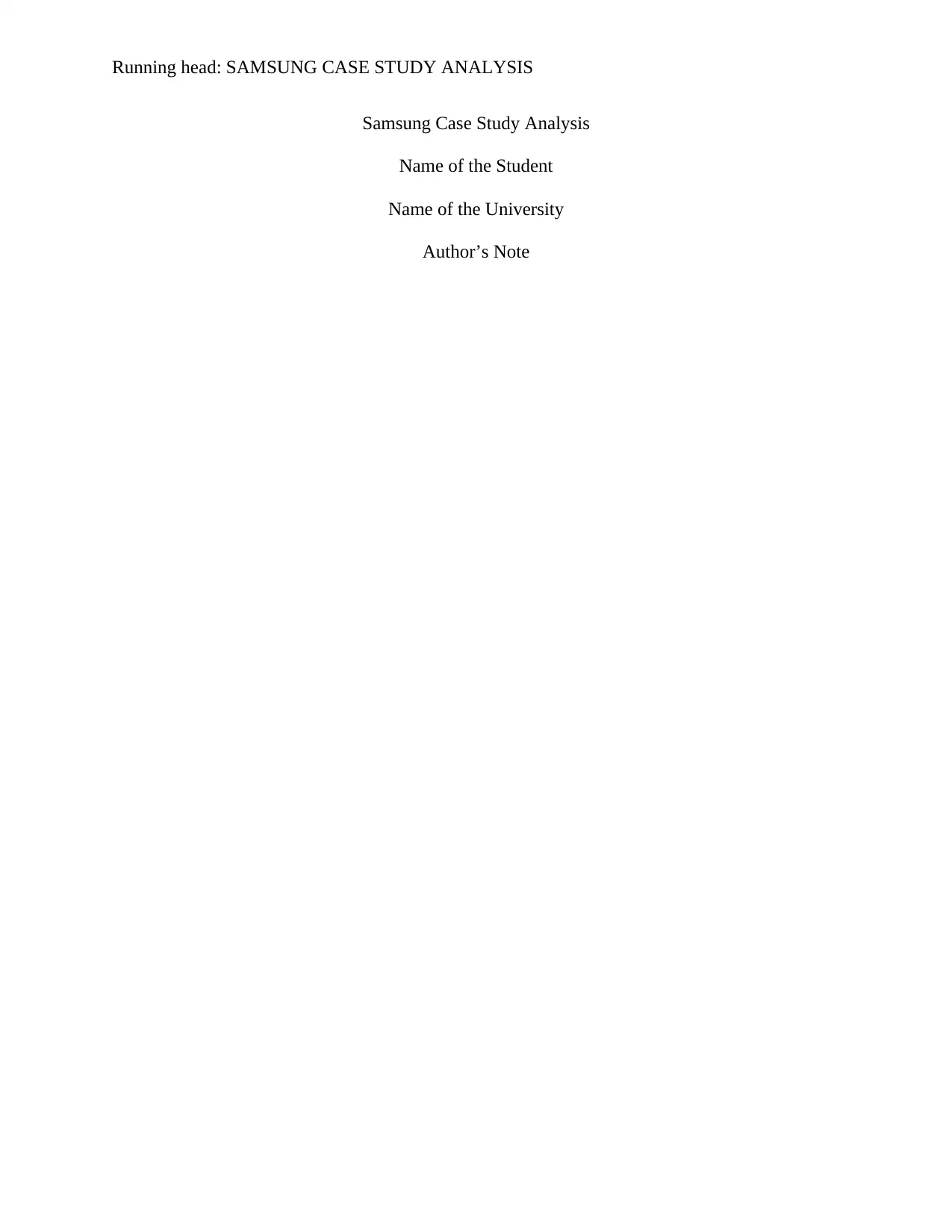
Running head: SAMSUNG CASE STUDY ANALYSIS
Samsung Case Study Analysis
Name of the Student
Name of the University
Author’s Note
Samsung Case Study Analysis
Name of the Student
Name of the University
Author’s Note
Paraphrase This Document
Need a fresh take? Get an instant paraphrase of this document with our AI Paraphraser
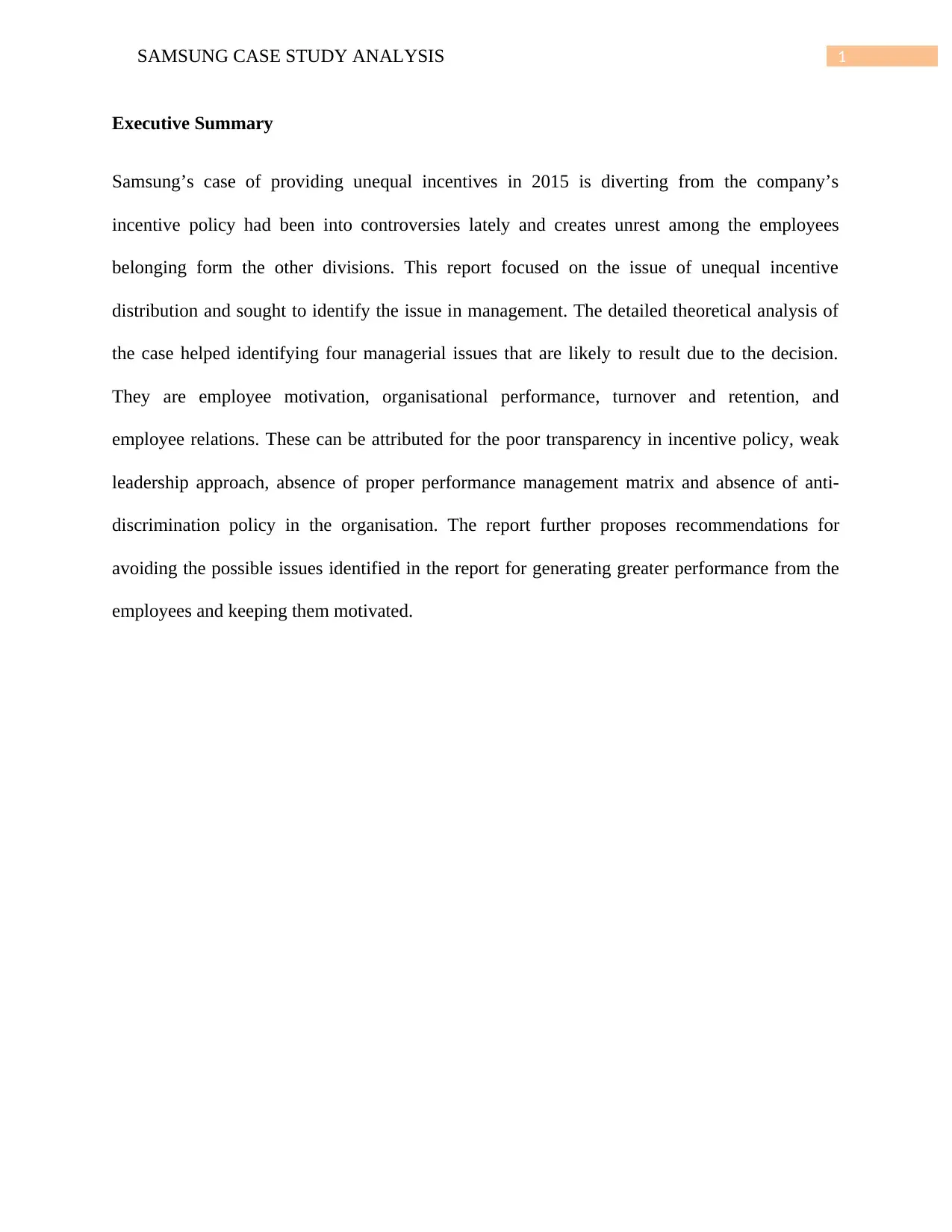
1SAMSUNG CASE STUDY ANALYSIS
Executive Summary
Samsung’s case of providing unequal incentives in 2015 is diverting from the company’s
incentive policy had been into controversies lately and creates unrest among the employees
belonging form the other divisions. This report focused on the issue of unequal incentive
distribution and sought to identify the issue in management. The detailed theoretical analysis of
the case helped identifying four managerial issues that are likely to result due to the decision.
They are employee motivation, organisational performance, turnover and retention, and
employee relations. These can be attributed for the poor transparency in incentive policy, weak
leadership approach, absence of proper performance management matrix and absence of anti-
discrimination policy in the organisation. The report further proposes recommendations for
avoiding the possible issues identified in the report for generating greater performance from the
employees and keeping them motivated.
Executive Summary
Samsung’s case of providing unequal incentives in 2015 is diverting from the company’s
incentive policy had been into controversies lately and creates unrest among the employees
belonging form the other divisions. This report focused on the issue of unequal incentive
distribution and sought to identify the issue in management. The detailed theoretical analysis of
the case helped identifying four managerial issues that are likely to result due to the decision.
They are employee motivation, organisational performance, turnover and retention, and
employee relations. These can be attributed for the poor transparency in incentive policy, weak
leadership approach, absence of proper performance management matrix and absence of anti-
discrimination policy in the organisation. The report further proposes recommendations for
avoiding the possible issues identified in the report for generating greater performance from the
employees and keeping them motivated.
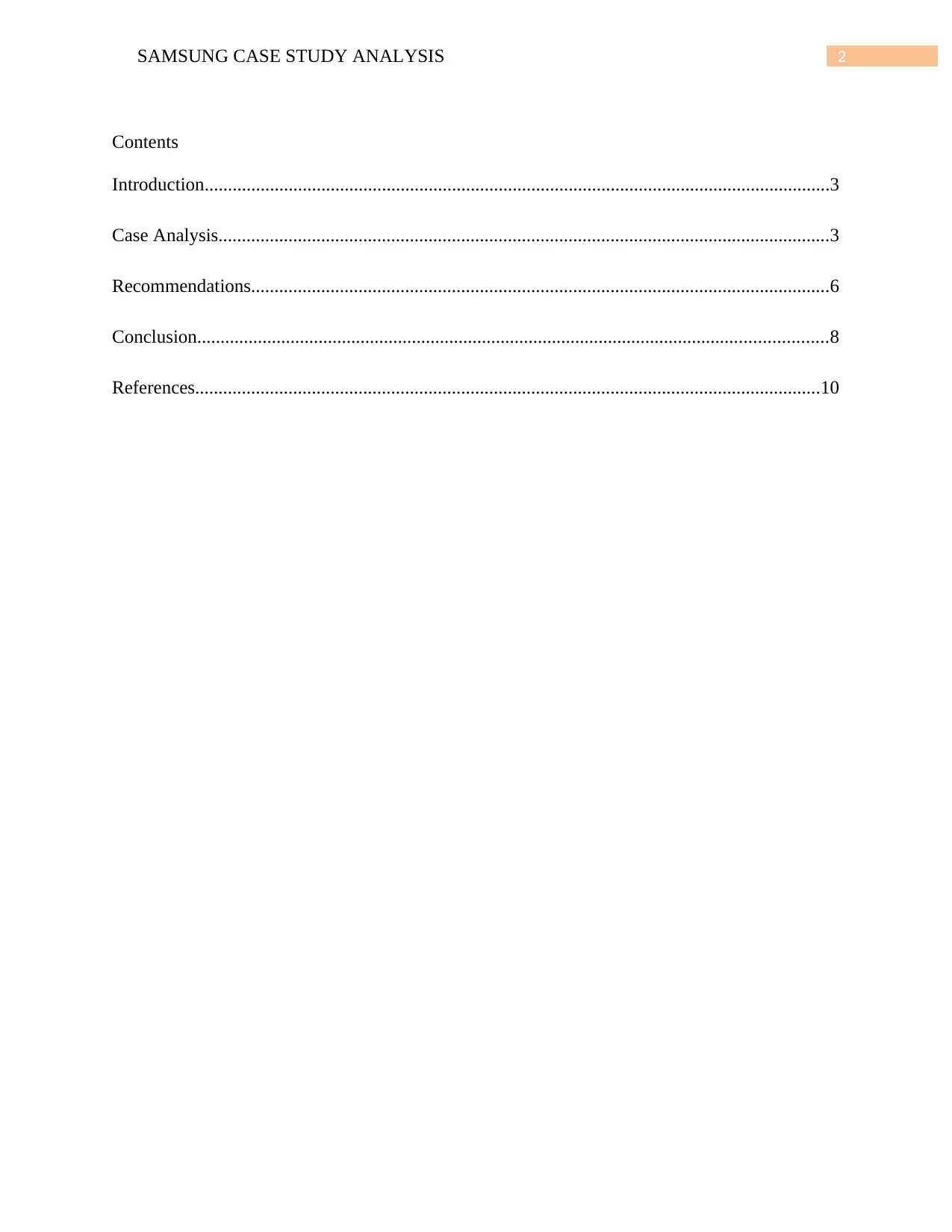
2SAMSUNG CASE STUDY ANALYSIS
Contents
Introduction......................................................................................................................................3
Case Analysis...................................................................................................................................3
Recommendations............................................................................................................................6
Conclusion.......................................................................................................................................8
References......................................................................................................................................10
Contents
Introduction......................................................................................................................................3
Case Analysis...................................................................................................................................3
Recommendations............................................................................................................................6
Conclusion.......................................................................................................................................8
References......................................................................................................................................10
⊘ This is a preview!⊘
Do you want full access?
Subscribe today to unlock all pages.

Trusted by 1+ million students worldwide
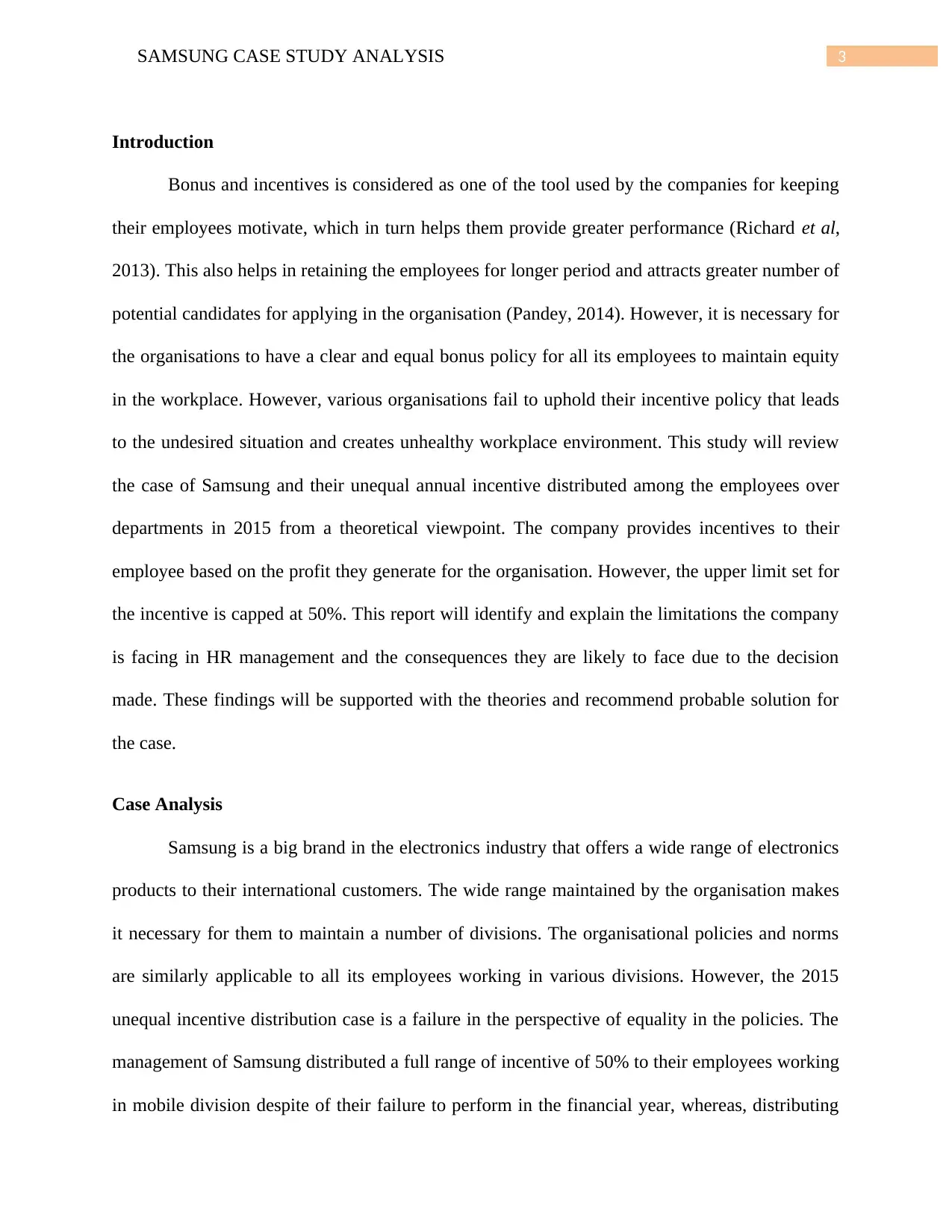
3SAMSUNG CASE STUDY ANALYSIS
Introduction
Bonus and incentives is considered as one of the tool used by the companies for keeping
their employees motivate, which in turn helps them provide greater performance (Richard et al,
2013). This also helps in retaining the employees for longer period and attracts greater number of
potential candidates for applying in the organisation (Pandey, 2014). However, it is necessary for
the organisations to have a clear and equal bonus policy for all its employees to maintain equity
in the workplace. However, various organisations fail to uphold their incentive policy that leads
to the undesired situation and creates unhealthy workplace environment. This study will review
the case of Samsung and their unequal annual incentive distributed among the employees over
departments in 2015 from a theoretical viewpoint. The company provides incentives to their
employee based on the profit they generate for the organisation. However, the upper limit set for
the incentive is capped at 50%. This report will identify and explain the limitations the company
is facing in HR management and the consequences they are likely to face due to the decision
made. These findings will be supported with the theories and recommend probable solution for
the case.
Case Analysis
Samsung is a big brand in the electronics industry that offers a wide range of electronics
products to their international customers. The wide range maintained by the organisation makes
it necessary for them to maintain a number of divisions. The organisational policies and norms
are similarly applicable to all its employees working in various divisions. However, the 2015
unequal incentive distribution case is a failure in the perspective of equality in the policies. The
management of Samsung distributed a full range of incentive of 50% to their employees working
in mobile division despite of their failure to perform in the financial year, whereas, distributing
Introduction
Bonus and incentives is considered as one of the tool used by the companies for keeping
their employees motivate, which in turn helps them provide greater performance (Richard et al,
2013). This also helps in retaining the employees for longer period and attracts greater number of
potential candidates for applying in the organisation (Pandey, 2014). However, it is necessary for
the organisations to have a clear and equal bonus policy for all its employees to maintain equity
in the workplace. However, various organisations fail to uphold their incentive policy that leads
to the undesired situation and creates unhealthy workplace environment. This study will review
the case of Samsung and their unequal annual incentive distributed among the employees over
departments in 2015 from a theoretical viewpoint. The company provides incentives to their
employee based on the profit they generate for the organisation. However, the upper limit set for
the incentive is capped at 50%. This report will identify and explain the limitations the company
is facing in HR management and the consequences they are likely to face due to the decision
made. These findings will be supported with the theories and recommend probable solution for
the case.
Case Analysis
Samsung is a big brand in the electronics industry that offers a wide range of electronics
products to their international customers. The wide range maintained by the organisation makes
it necessary for them to maintain a number of divisions. The organisational policies and norms
are similarly applicable to all its employees working in various divisions. However, the 2015
unequal incentive distribution case is a failure in the perspective of equality in the policies. The
management of Samsung distributed a full range of incentive of 50% to their employees working
in mobile division despite of their failure to perform in the financial year, whereas, distributing
Paraphrase This Document
Need a fresh take? Get an instant paraphrase of this document with our AI Paraphraser
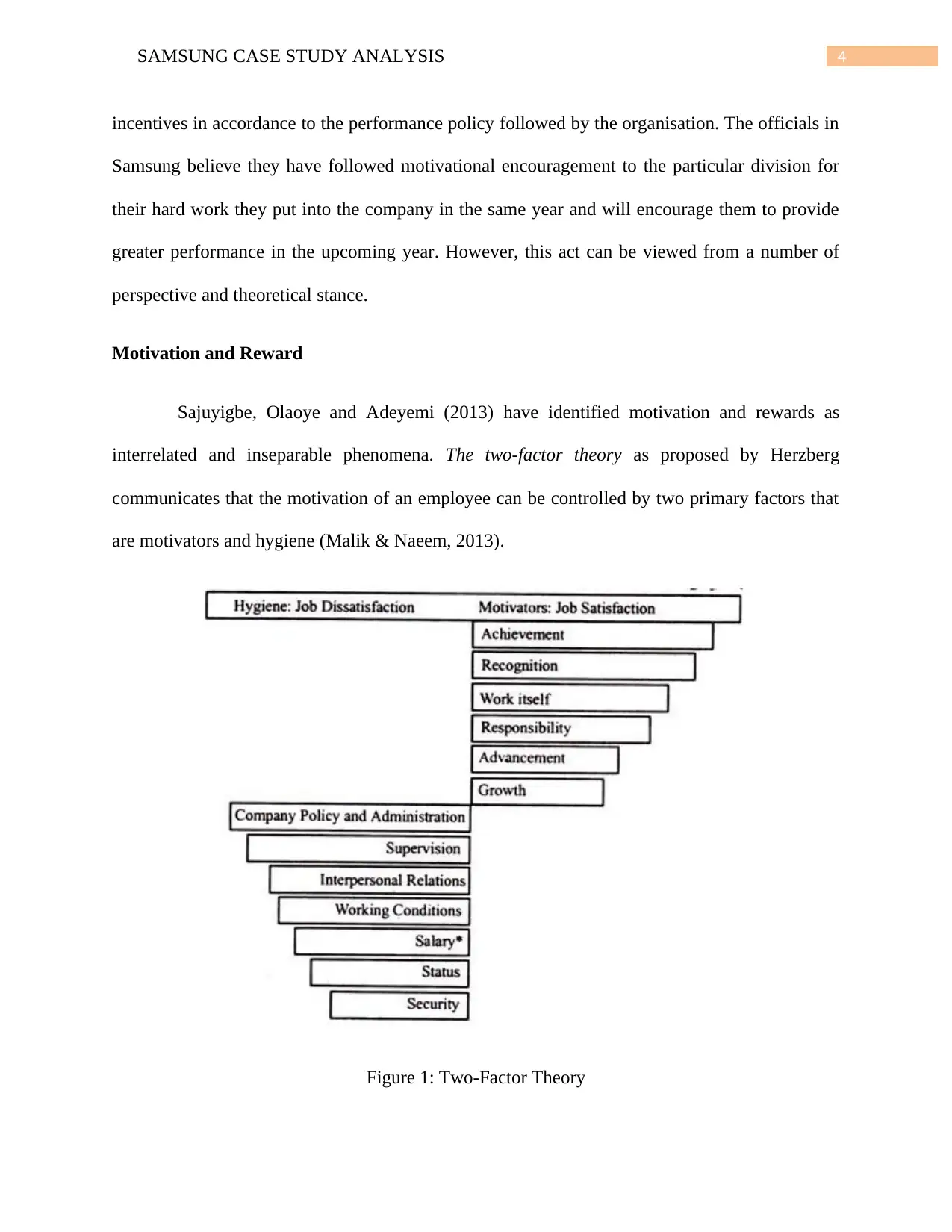
4SAMSUNG CASE STUDY ANALYSIS
incentives in accordance to the performance policy followed by the organisation. The officials in
Samsung believe they have followed motivational encouragement to the particular division for
their hard work they put into the company in the same year and will encourage them to provide
greater performance in the upcoming year. However, this act can be viewed from a number of
perspective and theoretical stance.
Motivation and Reward
Sajuyigbe, Olaoye and Adeyemi (2013) have identified motivation and rewards as
interrelated and inseparable phenomena. The two-factor theory as proposed by Herzberg
communicates that the motivation of an employee can be controlled by two primary factors that
are motivators and hygiene (Malik & Naeem, 2013).
Figure 1: Two-Factor Theory
incentives in accordance to the performance policy followed by the organisation. The officials in
Samsung believe they have followed motivational encouragement to the particular division for
their hard work they put into the company in the same year and will encourage them to provide
greater performance in the upcoming year. However, this act can be viewed from a number of
perspective and theoretical stance.
Motivation and Reward
Sajuyigbe, Olaoye and Adeyemi (2013) have identified motivation and rewards as
interrelated and inseparable phenomena. The two-factor theory as proposed by Herzberg
communicates that the motivation of an employee can be controlled by two primary factors that
are motivators and hygiene (Malik & Naeem, 2013).
Figure 1: Two-Factor Theory
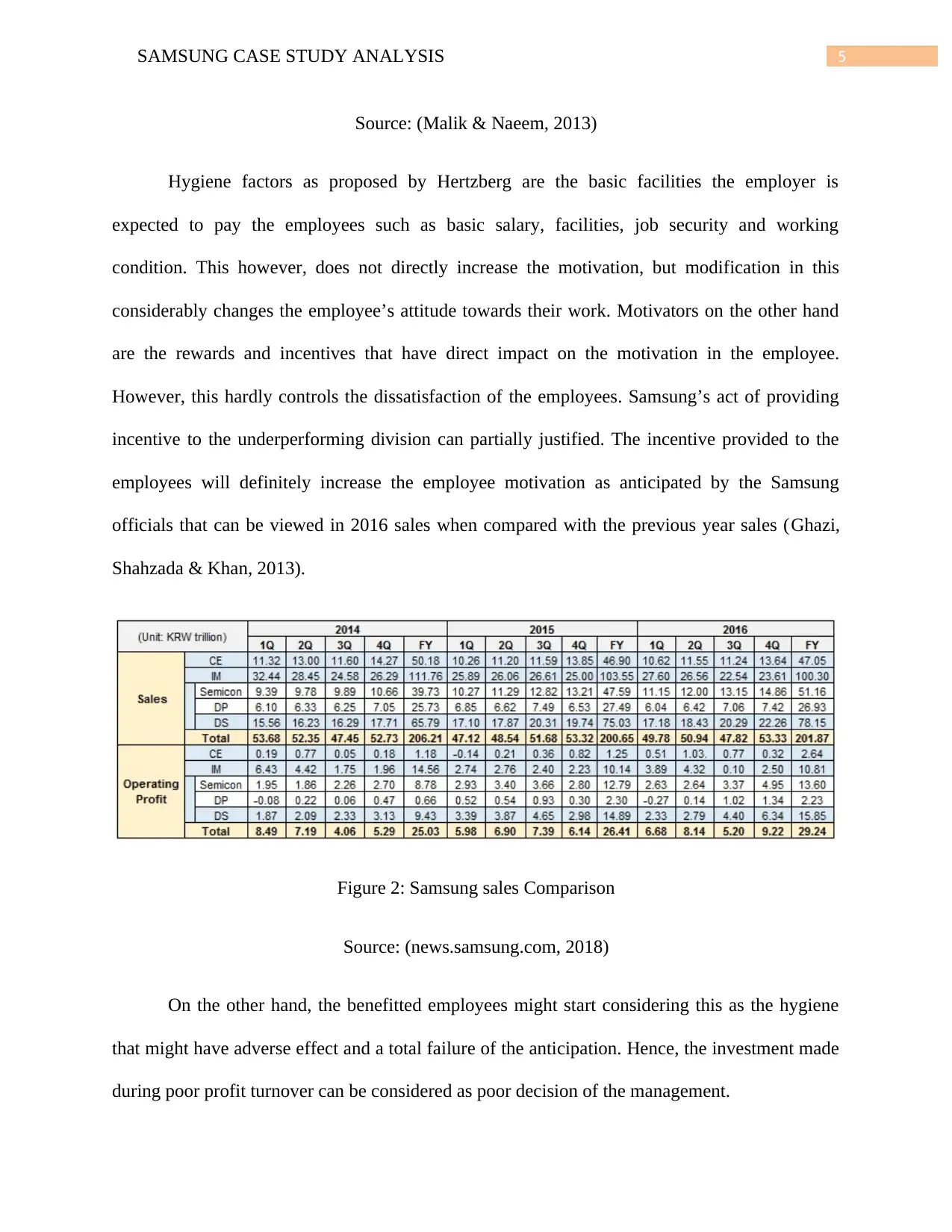
5SAMSUNG CASE STUDY ANALYSIS
Source: (Malik & Naeem, 2013)
Hygiene factors as proposed by Hertzberg are the basic facilities the employer is
expected to pay the employees such as basic salary, facilities, job security and working
condition. This however, does not directly increase the motivation, but modification in this
considerably changes the employee’s attitude towards their work. Motivators on the other hand
are the rewards and incentives that have direct impact on the motivation in the employee.
However, this hardly controls the dissatisfaction of the employees. Samsung’s act of providing
incentive to the underperforming division can partially justified. The incentive provided to the
employees will definitely increase the employee motivation as anticipated by the Samsung
officials that can be viewed in 2016 sales when compared with the previous year sales (Ghazi,
Shahzada & Khan, 2013).
Figure 2: Samsung sales Comparison
Source: (news.samsung.com, 2018)
On the other hand, the benefitted employees might start considering this as the hygiene
that might have adverse effect and a total failure of the anticipation. Hence, the investment made
during poor profit turnover can be considered as poor decision of the management.
Source: (Malik & Naeem, 2013)
Hygiene factors as proposed by Hertzberg are the basic facilities the employer is
expected to pay the employees such as basic salary, facilities, job security and working
condition. This however, does not directly increase the motivation, but modification in this
considerably changes the employee’s attitude towards their work. Motivators on the other hand
are the rewards and incentives that have direct impact on the motivation in the employee.
However, this hardly controls the dissatisfaction of the employees. Samsung’s act of providing
incentive to the underperforming division can partially justified. The incentive provided to the
employees will definitely increase the employee motivation as anticipated by the Samsung
officials that can be viewed in 2016 sales when compared with the previous year sales (Ghazi,
Shahzada & Khan, 2013).
Figure 2: Samsung sales Comparison
Source: (news.samsung.com, 2018)
On the other hand, the benefitted employees might start considering this as the hygiene
that might have adverse effect and a total failure of the anticipation. Hence, the investment made
during poor profit turnover can be considered as poor decision of the management.
⊘ This is a preview!⊘
Do you want full access?
Subscribe today to unlock all pages.

Trusted by 1+ million students worldwide
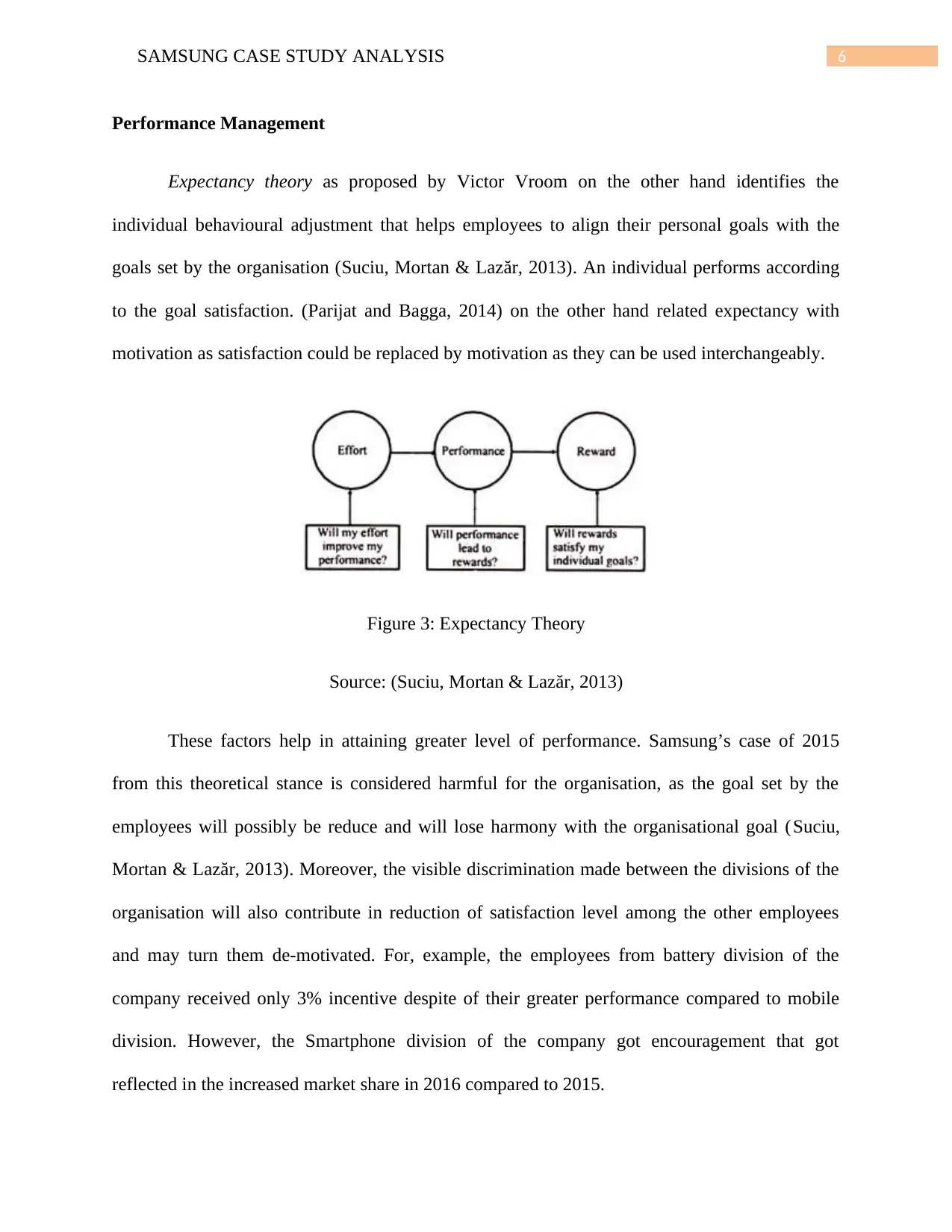
6SAMSUNG CASE STUDY ANALYSIS
Performance Management
Expectancy theory as proposed by Victor Vroom on the other hand identifies the
individual behavioural adjustment that helps employees to align their personal goals with the
goals set by the organisation (Suciu, Mortan & Lazăr, 2013). An individual performs according
to the goal satisfaction. (Parijat and Bagga, 2014) on the other hand related expectancy with
motivation as satisfaction could be replaced by motivation as they can be used interchangeably.
Figure 3: Expectancy Theory
Source: (Suciu, Mortan & Lazăr, 2013)
These factors help in attaining greater level of performance. Samsung’s case of 2015
from this theoretical stance is considered harmful for the organisation, as the goal set by the
employees will possibly be reduce and will lose harmony with the organisational goal (Suciu,
Mortan & Lazăr, 2013). Moreover, the visible discrimination made between the divisions of the
organisation will also contribute in reduction of satisfaction level among the other employees
and may turn them de-motivated. For, example, the employees from battery division of the
company received only 3% incentive despite of their greater performance compared to mobile
division. However, the Smartphone division of the company got encouragement that got
reflected in the increased market share in 2016 compared to 2015.
Performance Management
Expectancy theory as proposed by Victor Vroom on the other hand identifies the
individual behavioural adjustment that helps employees to align their personal goals with the
goals set by the organisation (Suciu, Mortan & Lazăr, 2013). An individual performs according
to the goal satisfaction. (Parijat and Bagga, 2014) on the other hand related expectancy with
motivation as satisfaction could be replaced by motivation as they can be used interchangeably.
Figure 3: Expectancy Theory
Source: (Suciu, Mortan & Lazăr, 2013)
These factors help in attaining greater level of performance. Samsung’s case of 2015
from this theoretical stance is considered harmful for the organisation, as the goal set by the
employees will possibly be reduce and will lose harmony with the organisational goal (Suciu,
Mortan & Lazăr, 2013). Moreover, the visible discrimination made between the divisions of the
organisation will also contribute in reduction of satisfaction level among the other employees
and may turn them de-motivated. For, example, the employees from battery division of the
company received only 3% incentive despite of their greater performance compared to mobile
division. However, the Smartphone division of the company got encouragement that got
reflected in the increased market share in 2016 compared to 2015.
Paraphrase This Document
Need a fresh take? Get an instant paraphrase of this document with our AI Paraphraser
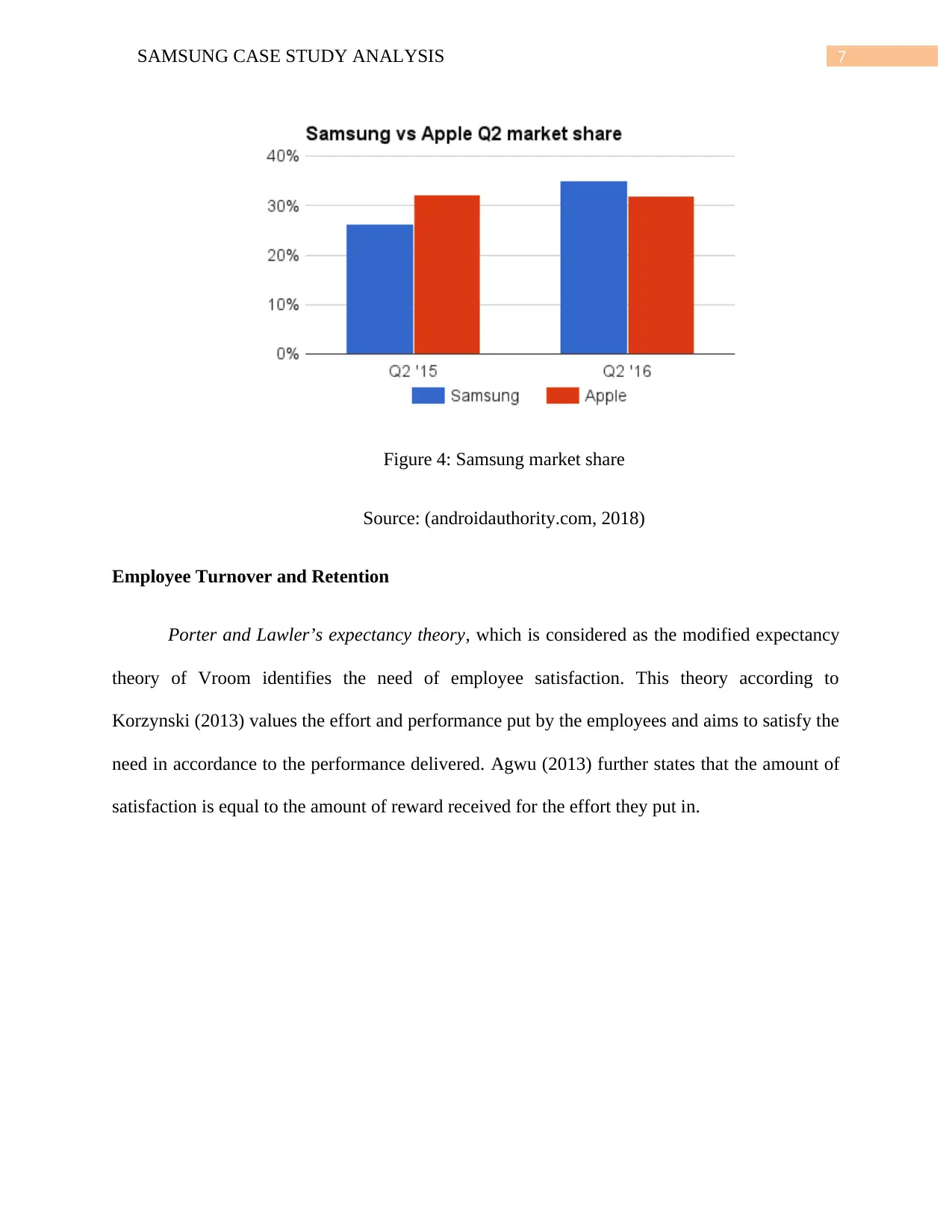
7SAMSUNG CASE STUDY ANALYSIS
Figure 4: Samsung market share
Source: (androidauthority.com, 2018)
Employee Turnover and Retention
Porter and Lawler’s expectancy theory, which is considered as the modified expectancy
theory of Vroom identifies the need of employee satisfaction. This theory according to
Korzynski (2013) values the effort and performance put by the employees and aims to satisfy the
need in accordance to the performance delivered. Agwu (2013) further states that the amount of
satisfaction is equal to the amount of reward received for the effort they put in.
Figure 4: Samsung market share
Source: (androidauthority.com, 2018)
Employee Turnover and Retention
Porter and Lawler’s expectancy theory, which is considered as the modified expectancy
theory of Vroom identifies the need of employee satisfaction. This theory according to
Korzynski (2013) values the effort and performance put by the employees and aims to satisfy the
need in accordance to the performance delivered. Agwu (2013) further states that the amount of
satisfaction is equal to the amount of reward received for the effort they put in.
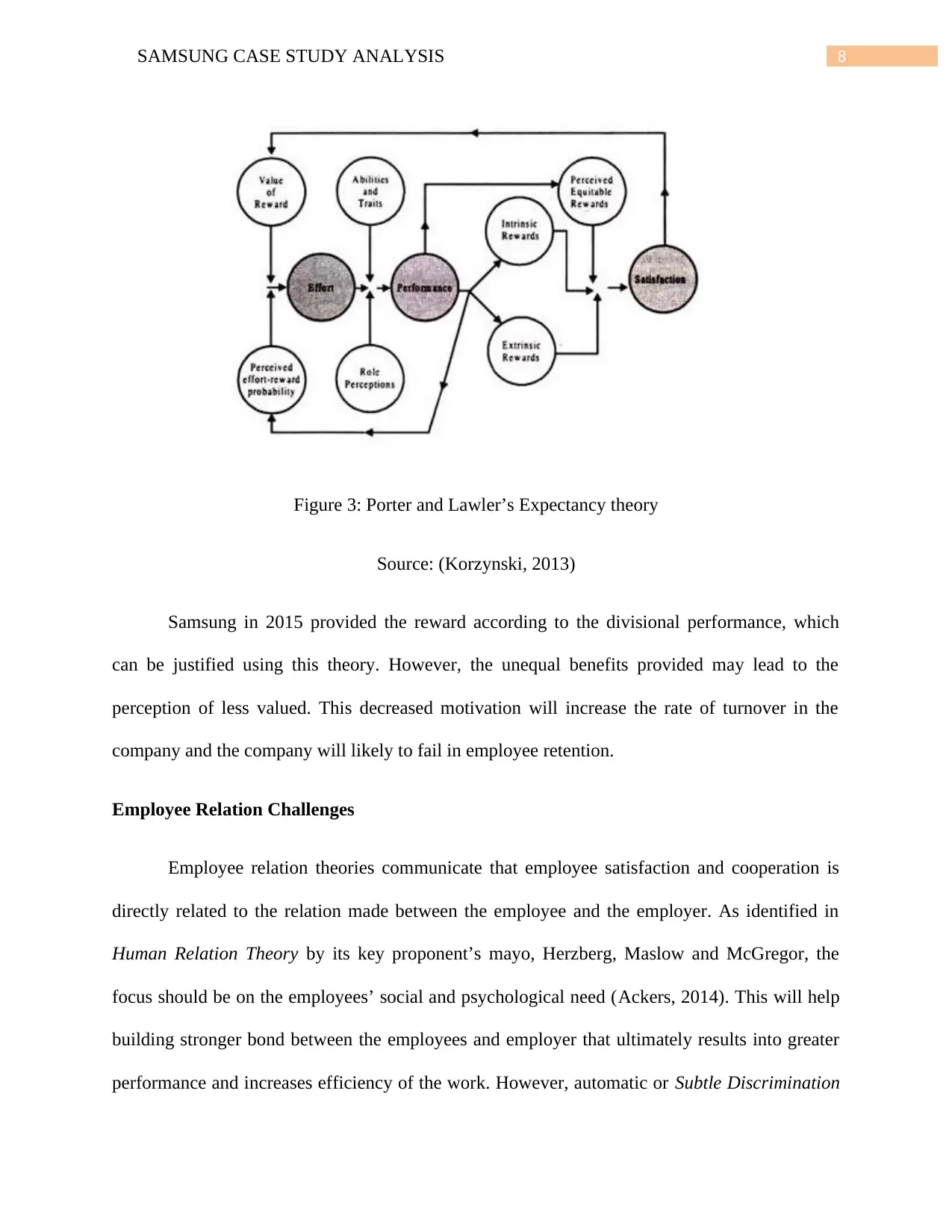
8SAMSUNG CASE STUDY ANALYSIS
Figure 3: Porter and Lawler’s Expectancy theory
Source: (Korzynski, 2013)
Samsung in 2015 provided the reward according to the divisional performance, which
can be justified using this theory. However, the unequal benefits provided may lead to the
perception of less valued. This decreased motivation will increase the rate of turnover in the
company and the company will likely to fail in employee retention.
Employee Relation Challenges
Employee relation theories communicate that employee satisfaction and cooperation is
directly related to the relation made between the employee and the employer. As identified in
Human Relation Theory by its key proponent’s mayo, Herzberg, Maslow and McGregor, the
focus should be on the employees’ social and psychological need (Ackers, 2014). This will help
building stronger bond between the employees and employer that ultimately results into greater
performance and increases efficiency of the work. However, automatic or Subtle Discrimination
Figure 3: Porter and Lawler’s Expectancy theory
Source: (Korzynski, 2013)
Samsung in 2015 provided the reward according to the divisional performance, which
can be justified using this theory. However, the unequal benefits provided may lead to the
perception of less valued. This decreased motivation will increase the rate of turnover in the
company and the company will likely to fail in employee retention.
Employee Relation Challenges
Employee relation theories communicate that employee satisfaction and cooperation is
directly related to the relation made between the employee and the employer. As identified in
Human Relation Theory by its key proponent’s mayo, Herzberg, Maslow and McGregor, the
focus should be on the employees’ social and psychological need (Ackers, 2014). This will help
building stronger bond between the employees and employer that ultimately results into greater
performance and increases efficiency of the work. However, automatic or Subtle Discrimination
⊘ This is a preview!⊘
Do you want full access?
Subscribe today to unlock all pages.

Trusted by 1+ million students worldwide
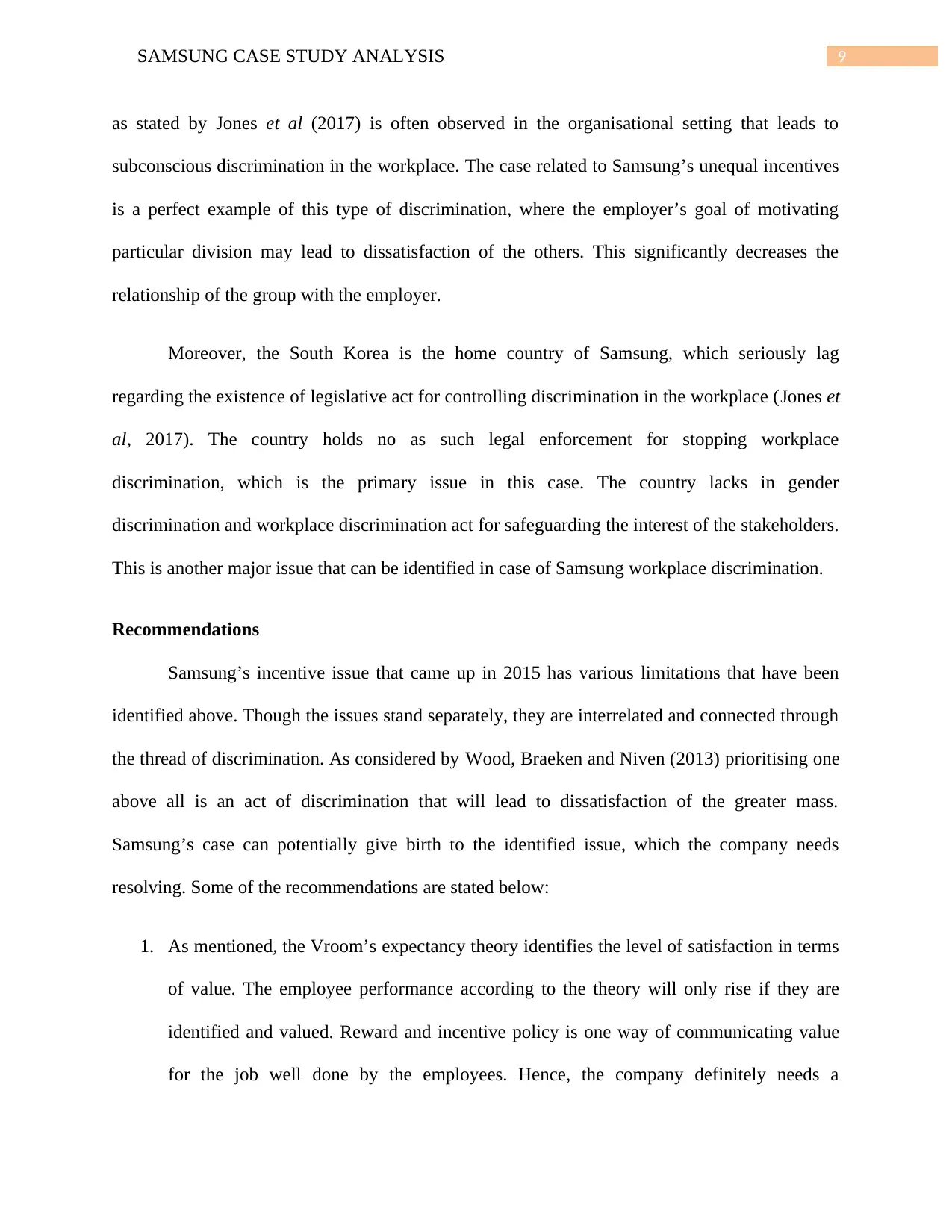
9SAMSUNG CASE STUDY ANALYSIS
as stated by Jones et al (2017) is often observed in the organisational setting that leads to
subconscious discrimination in the workplace. The case related to Samsung’s unequal incentives
is a perfect example of this type of discrimination, where the employer’s goal of motivating
particular division may lead to dissatisfaction of the others. This significantly decreases the
relationship of the group with the employer.
Moreover, the South Korea is the home country of Samsung, which seriously lag
regarding the existence of legislative act for controlling discrimination in the workplace (Jones et
al, 2017). The country holds no as such legal enforcement for stopping workplace
discrimination, which is the primary issue in this case. The country lacks in gender
discrimination and workplace discrimination act for safeguarding the interest of the stakeholders.
This is another major issue that can be identified in case of Samsung workplace discrimination.
Recommendations
Samsung’s incentive issue that came up in 2015 has various limitations that have been
identified above. Though the issues stand separately, they are interrelated and connected through
the thread of discrimination. As considered by Wood, Braeken and Niven (2013) prioritising one
above all is an act of discrimination that will lead to dissatisfaction of the greater mass.
Samsung’s case can potentially give birth to the identified issue, which the company needs
resolving. Some of the recommendations are stated below:
1. As mentioned, the Vroom’s expectancy theory identifies the level of satisfaction in terms
of value. The employee performance according to the theory will only rise if they are
identified and valued. Reward and incentive policy is one way of communicating value
for the job well done by the employees. Hence, the company definitely needs a
as stated by Jones et al (2017) is often observed in the organisational setting that leads to
subconscious discrimination in the workplace. The case related to Samsung’s unequal incentives
is a perfect example of this type of discrimination, where the employer’s goal of motivating
particular division may lead to dissatisfaction of the others. This significantly decreases the
relationship of the group with the employer.
Moreover, the South Korea is the home country of Samsung, which seriously lag
regarding the existence of legislative act for controlling discrimination in the workplace (Jones et
al, 2017). The country holds no as such legal enforcement for stopping workplace
discrimination, which is the primary issue in this case. The country lacks in gender
discrimination and workplace discrimination act for safeguarding the interest of the stakeholders.
This is another major issue that can be identified in case of Samsung workplace discrimination.
Recommendations
Samsung’s incentive issue that came up in 2015 has various limitations that have been
identified above. Though the issues stand separately, they are interrelated and connected through
the thread of discrimination. As considered by Wood, Braeken and Niven (2013) prioritising one
above all is an act of discrimination that will lead to dissatisfaction of the greater mass.
Samsung’s case can potentially give birth to the identified issue, which the company needs
resolving. Some of the recommendations are stated below:
1. As mentioned, the Vroom’s expectancy theory identifies the level of satisfaction in terms
of value. The employee performance according to the theory will only rise if they are
identified and valued. Reward and incentive policy is one way of communicating value
for the job well done by the employees. Hence, the company definitely needs a
Paraphrase This Document
Need a fresh take? Get an instant paraphrase of this document with our AI Paraphraser
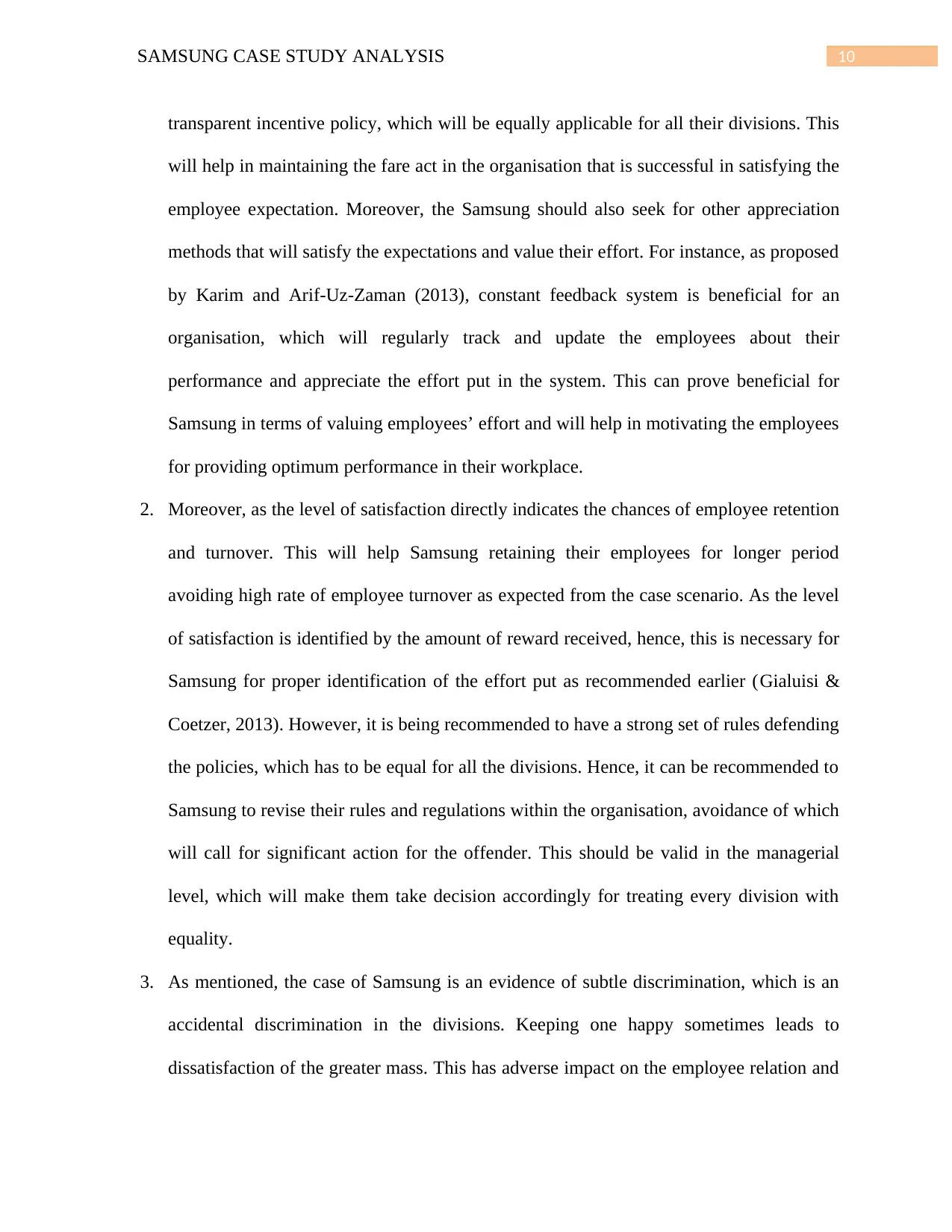
10SAMSUNG CASE STUDY ANALYSIS
transparent incentive policy, which will be equally applicable for all their divisions. This
will help in maintaining the fare act in the organisation that is successful in satisfying the
employee expectation. Moreover, the Samsung should also seek for other appreciation
methods that will satisfy the expectations and value their effort. For instance, as proposed
by Karim and Arif-Uz-Zaman (2013), constant feedback system is beneficial for an
organisation, which will regularly track and update the employees about their
performance and appreciate the effort put in the system. This can prove beneficial for
Samsung in terms of valuing employees’ effort and will help in motivating the employees
for providing optimum performance in their workplace.
2. Moreover, as the level of satisfaction directly indicates the chances of employee retention
and turnover. This will help Samsung retaining their employees for longer period
avoiding high rate of employee turnover as expected from the case scenario. As the level
of satisfaction is identified by the amount of reward received, hence, this is necessary for
Samsung for proper identification of the effort put as recommended earlier (Gialuisi &
Coetzer, 2013). However, it is being recommended to have a strong set of rules defending
the policies, which has to be equal for all the divisions. Hence, it can be recommended to
Samsung to revise their rules and regulations within the organisation, avoidance of which
will call for significant action for the offender. This should be valid in the managerial
level, which will make them take decision accordingly for treating every division with
equality.
3. As mentioned, the case of Samsung is an evidence of subtle discrimination, which is an
accidental discrimination in the divisions. Keeping one happy sometimes leads to
dissatisfaction of the greater mass. This has adverse impact on the employee relation and
transparent incentive policy, which will be equally applicable for all their divisions. This
will help in maintaining the fare act in the organisation that is successful in satisfying the
employee expectation. Moreover, the Samsung should also seek for other appreciation
methods that will satisfy the expectations and value their effort. For instance, as proposed
by Karim and Arif-Uz-Zaman (2013), constant feedback system is beneficial for an
organisation, which will regularly track and update the employees about their
performance and appreciate the effort put in the system. This can prove beneficial for
Samsung in terms of valuing employees’ effort and will help in motivating the employees
for providing optimum performance in their workplace.
2. Moreover, as the level of satisfaction directly indicates the chances of employee retention
and turnover. This will help Samsung retaining their employees for longer period
avoiding high rate of employee turnover as expected from the case scenario. As the level
of satisfaction is identified by the amount of reward received, hence, this is necessary for
Samsung for proper identification of the effort put as recommended earlier (Gialuisi &
Coetzer, 2013). However, it is being recommended to have a strong set of rules defending
the policies, which has to be equal for all the divisions. Hence, it can be recommended to
Samsung to revise their rules and regulations within the organisation, avoidance of which
will call for significant action for the offender. This should be valid in the managerial
level, which will make them take decision accordingly for treating every division with
equality.
3. As mentioned, the case of Samsung is an evidence of subtle discrimination, which is an
accidental discrimination in the divisions. Keeping one happy sometimes leads to
dissatisfaction of the greater mass. This has adverse impact on the employee relation and
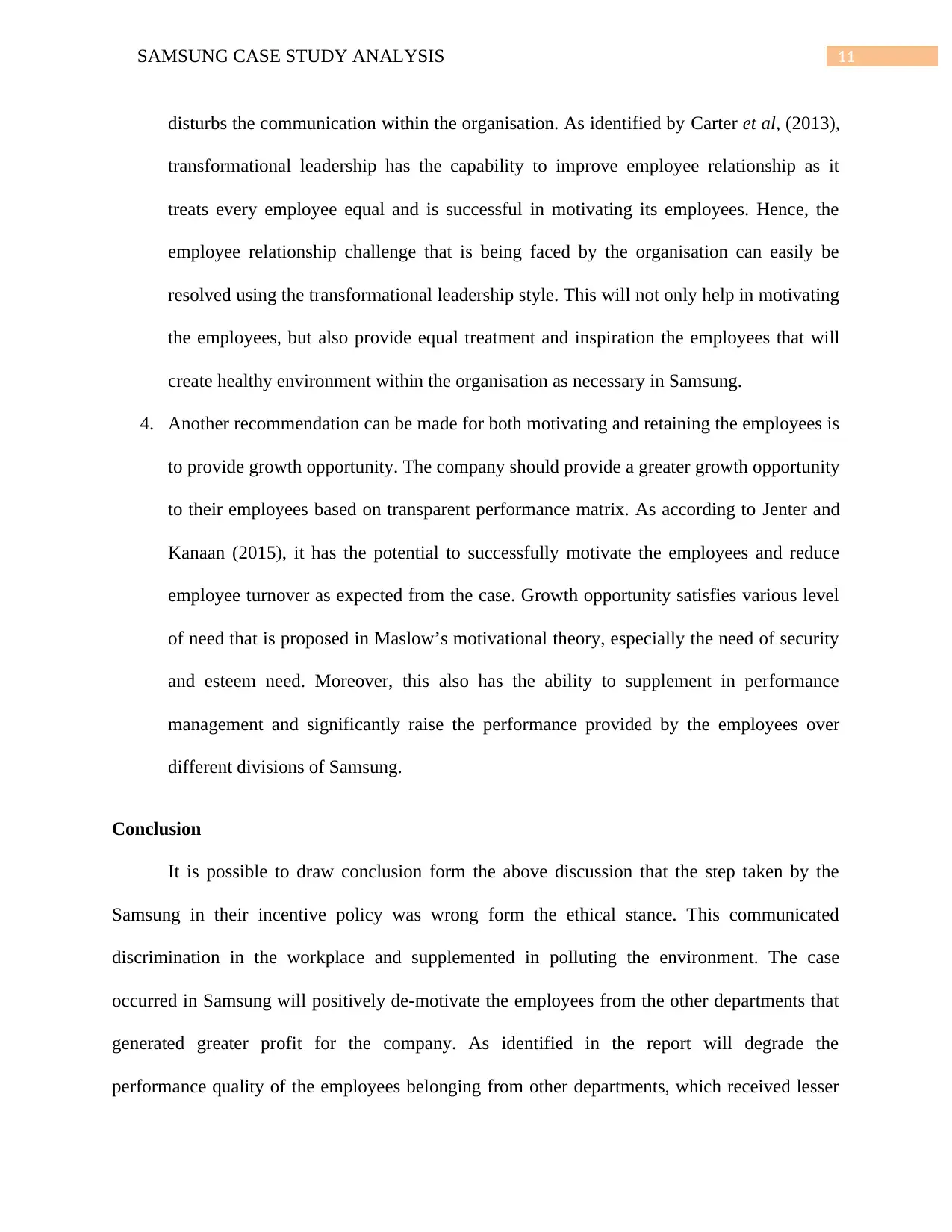
11SAMSUNG CASE STUDY ANALYSIS
disturbs the communication within the organisation. As identified by Carter et al, (2013),
transformational leadership has the capability to improve employee relationship as it
treats every employee equal and is successful in motivating its employees. Hence, the
employee relationship challenge that is being faced by the organisation can easily be
resolved using the transformational leadership style. This will not only help in motivating
the employees, but also provide equal treatment and inspiration the employees that will
create healthy environment within the organisation as necessary in Samsung.
4. Another recommendation can be made for both motivating and retaining the employees is
to provide growth opportunity. The company should provide a greater growth opportunity
to their employees based on transparent performance matrix. As according to Jenter and
Kanaan (2015), it has the potential to successfully motivate the employees and reduce
employee turnover as expected from the case. Growth opportunity satisfies various level
of need that is proposed in Maslow’s motivational theory, especially the need of security
and esteem need. Moreover, this also has the ability to supplement in performance
management and significantly raise the performance provided by the employees over
different divisions of Samsung.
Conclusion
It is possible to draw conclusion form the above discussion that the step taken by the
Samsung in their incentive policy was wrong form the ethical stance. This communicated
discrimination in the workplace and supplemented in polluting the environment. The case
occurred in Samsung will positively de-motivate the employees from the other departments that
generated greater profit for the company. As identified in the report will degrade the
performance quality of the employees belonging from other departments, which received lesser
disturbs the communication within the organisation. As identified by Carter et al, (2013),
transformational leadership has the capability to improve employee relationship as it
treats every employee equal and is successful in motivating its employees. Hence, the
employee relationship challenge that is being faced by the organisation can easily be
resolved using the transformational leadership style. This will not only help in motivating
the employees, but also provide equal treatment and inspiration the employees that will
create healthy environment within the organisation as necessary in Samsung.
4. Another recommendation can be made for both motivating and retaining the employees is
to provide growth opportunity. The company should provide a greater growth opportunity
to their employees based on transparent performance matrix. As according to Jenter and
Kanaan (2015), it has the potential to successfully motivate the employees and reduce
employee turnover as expected from the case. Growth opportunity satisfies various level
of need that is proposed in Maslow’s motivational theory, especially the need of security
and esteem need. Moreover, this also has the ability to supplement in performance
management and significantly raise the performance provided by the employees over
different divisions of Samsung.
Conclusion
It is possible to draw conclusion form the above discussion that the step taken by the
Samsung in their incentive policy was wrong form the ethical stance. This communicated
discrimination in the workplace and supplemented in polluting the environment. The case
occurred in Samsung will positively de-motivate the employees from the other departments that
generated greater profit for the company. As identified in the report will degrade the
performance quality of the employees belonging from other departments, which received lesser
⊘ This is a preview!⊘
Do you want full access?
Subscribe today to unlock all pages.

Trusted by 1+ million students worldwide
1 out of 16
Related Documents
Your All-in-One AI-Powered Toolkit for Academic Success.
+13062052269
info@desklib.com
Available 24*7 on WhatsApp / Email
![[object Object]](/_next/static/media/star-bottom.7253800d.svg)
Unlock your academic potential
Copyright © 2020–2025 A2Z Services. All Rights Reserved. Developed and managed by ZUCOL.





